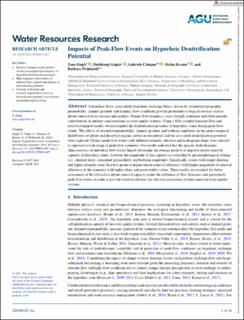| dc.contributor.author | Singh, Tanu | |
| dc.contributor.author | Gupta, Shubhangi | |
| dc.contributor.author | Chiogna, Gabriele | |
| dc.contributor.author | Krause, Stefan | |
| dc.contributor.author | Wohlmuth, Barbara Irmgard | |
| dc.date.accessioned | 2023-03-01T13:42:56Z | |
| dc.date.available | 2023-03-01T13:42:56Z | |
| dc.date.created | 2022-06-07T13:20:36Z | |
| dc.date.issued | 2022 | |
| dc.identifier.issn | 0043-1397 | |
| dc.identifier.uri | https://hdl.handle.net/11250/3055050 | |
| dc.description.abstract | Subsurface flows, particularly hyporheic exchange fluxes, driven by streambed topography, permeability, channel gradient and dynamic flow conditions provide prominent ecological services such as nitrate removal from streams and aquifers. Stream flow dynamics cause strongly nonlinear and often episodic contributions of nutrient concentrations in river-aquifer systems. Using a fully coupled transient flow and reactive transport model, we investigated the denitrification potential of hyporheic zones during peak-flow events. The effects of streambed permeability, channel gradient and bedform amplitude on the spatio-temporal distribution of nitrate and dissolved organic carbon in streambeds and the associated denitrification potential were explored. Distinct peak-flow events with different intensity, duration and hydrograph shape were selected to represent a wide range of peak-flow scenarios. Our results indicated that the specific hydrodynamic characteristics of individual flow events largely determine the average positive or negative nitrate removal capacity of hyporheic zones, however the magnitude of this capacity is controlled by geomorphological settings (i.e., channel slope, streambed permeability and bedform amplitude). Specifically, events with longer duration and higher intensity were shown to promote higher nitrate removal efficiency with higher magnitude of removal efficiency in the scenarios with higher slope and permeability values. These results are essential for better assessment of the subsurface nitrate removal capacity under the influence of flow dynamics and particularly peak-flow events in order to provide tailored solutions for effective restoration of interconnected river-aquifer systems. | en_US |
| dc.language.iso | eng | en_US |
| dc.publisher | AGU | en_US |
| dc.rights | Navngivelse 4.0 Internasjonal | * |
| dc.rights.uri | http://creativecommons.org/licenses/by/4.0/deed.no | * |
| dc.title | Impacts of Peak-Flow Events on Hyporheic Denitrification Potential | en_US |
| dc.type | Journal article | en_US |
| dc.type | Peer reviewed | en_US |
| dc.description.version | publishedVersion | en_US |
| dc.rights.holder | Copyright 2022 The Author(s) | en_US |
| dc.source.articlenumber | e2021WR031407 | en_US |
| cristin.ispublished | true | |
| cristin.fulltext | original | |
| cristin.qualitycode | 1 | |
| dc.identifier.doi | 10.1029/2021WR031407 | |
| dc.identifier.cristin | 2029882 | |
| dc.source.journal | Water Resources Research | en_US |
| dc.identifier.citation | Water Resources Research. 2022, 58 (3), e2021WR031407. | en_US |
| dc.source.volume | 58 | en_US |
| dc.source.issue | 3 | en_US |

